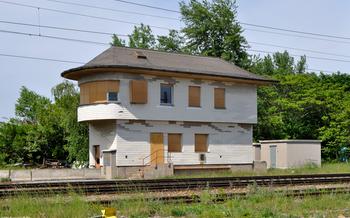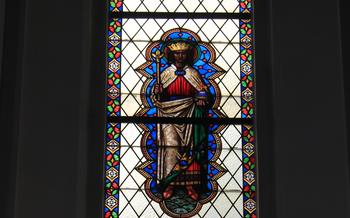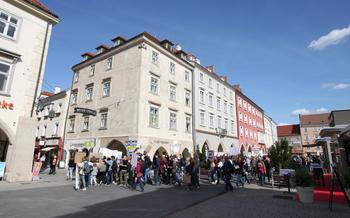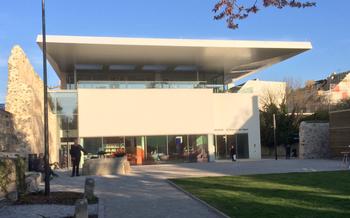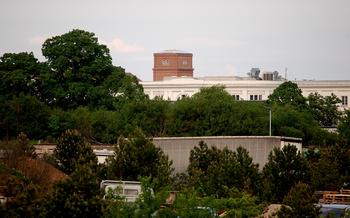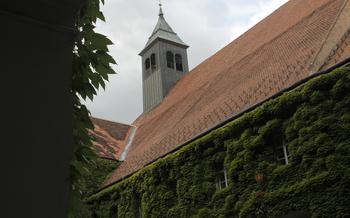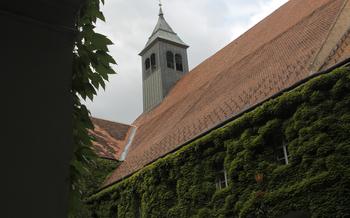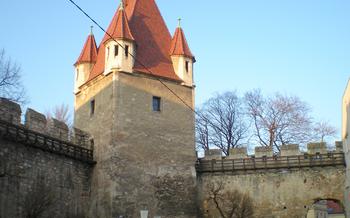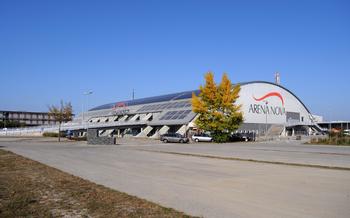
Wiener Neustadt Cathedral (Dom zu Wiener Neustadt)
- Wiener Neustadt Cathedral: A Stunning Masterpiece
- Exploring the Cathedral's History
- Architectural Highlights of the Exterior
- Marvels of the Cathedral's Interior
- The Cathedral's Role in the Community
- Visiting the Cathedral: Practical Information
- Unveiling the Cathedral's Crypts
- The Cathedral's Musical Heritage
- Legends and Mysteries Surrounding the Cathedral
- The Cathedral's Impact on the City's Skyline
- The Cathedral's Contribution to Religious Tourism
- The Cathedral's Role in Cultural Events
- Preserving the Cathedral's Legacy
- Insider Tip: Discovering Hidden Gems
Wiener Neustadt Cathedral: A Stunning Masterpiece
Nestled in the heart of Wiener Neustadt, Austria, stands the magnificent Wiener Neustadt Cathedral (Dom zu Wiener Neustadt), a stunning testament to the city's rich history and architectural prowess. Built in the 13th century, this Gothic masterpiece has served as a spiritual and cultural beacon for centuries, attracting visitors from far and wide.
The cathedral's exterior is a symphony of intricate carvings, delicate tracery, and soaring spires that pierce the sky. The striking facade, adorned with a multitude of gargoyles and statues, narrates biblical stories and legends in stone, capturing the imagination of all who behold it. Inside, the cathedral reveals an awe-inspiring nave with soaring arches, ribbed vaults, and an abundance of natural light filtering through the exquisite stained glass windows, creating an atmosphere of ethereal beauty and reverence.
Exploring the Cathedral's History
The Wiener Neustadt Cathedral has a rich and fascinating history that spans several centuries. Its origins can be traced back to the 13th century when the city of Wiener Neustadt was founded by Duke Leopold VI of Austria. The cathedral was initially a small chapel dedicated to Saint Peter, but it was later expanded and rebuilt in the Gothic style during the 14th and 15th centuries. Over time, the cathedral underwent several modifications and additions, reflecting the changing architectural styles and the growing importance of Wiener Neustadt as a religious and political center.
The cathedral's construction was influenced by various architectural styles, including Romanesque, Gothic, and Baroque. The Romanesque style is evident in the sturdy walls and rounded arches of the crypt, while the Gothic style is reflected in the pointed arches, ribbed vaults, and intricate carvings that adorn the exterior. The Baroque style is visible in the elaborate altarpieces and decorative elements that were added to the cathedral during the 17th and 18th centuries.
Throughout its history, the Wiener Neustadt Cathedral played a significant role in the city's religious and political life. It served as the seat of the Bishop of Wiener Neustadt and was the venue for important religious ceremonies and events. The cathedral was also closely associated with the Habsburg dynasty, who ruled Austria for centuries, and many members of the Habsburg family were buried in the cathedral's crypts.
Major events and milestones in the cathedral's history include its consecration in 1279, the elevation of Wiener Neustadt to a diocese in 1469, the devastating fire of 1636 that destroyed much of the cathedral's interior, and the subsequent rebuilding and renovation efforts that restored the cathedral to its former glory. The cathedral has withstood the test of time and remains a testament to the enduring faith and resilience of the people of Wiener Neustadt.
Architectural Highlights of the Exterior
The Wiener Neustadt Cathedral's exterior is a testament to the Gothic architectural style that dominated Europe during its construction. The striking facade is a masterpiece of intricate carvings and sculptures, showcasing the skill and artistry of the medieval craftsmen. The twin towers, reaching towards the sky, symbolize the cathedral's spiritual aspirations and its dominance over the city's skyline. The magnificent stained glass windows, depicting scenes from the Bible, bathe the interior in a kaleidoscope of colors, creating a sense of awe and wonder. The decorative elements, such as gargoyles and pinnacles, add a touch of whimsy and playfulness to the cathedral's otherwise solemn facade, inviting visitors to explore and discover its hidden details.
Marvels of the Cathedral's Interior
The interior of Wiener Neustadt Cathedral is a breathtaking spectacle, showcasing a harmonious blend of architectural grandeur and artistic mastery. As you step inside, the vast nave immediately captures your attention, with its soaring arches and intricate ribbed vaults creating an awe-inspiring sense of space.
The elaborate altarpieces, intricately carved from wood and adorned with gold leaf, are masterpieces of craftsmanship. Each altarpiece tells a biblical story through a combination of sculptures, paintings, and decorative elements, adding to the cathedral's rich iconography.
The choir stalls, located in the eastern part of the nave, are another highlight of the cathedral's interior. These finely carved wooden stalls, reserved for the clergy during religious ceremonies, feature intricate designs and symbolic motifs. The misericords, the small carvings beneath the seats, depict a variety of scenes, ranging from biblical narratives to mythical creatures, offering a glimpse into the medieval mindset.
The cathedral's impressive organ, situated above the main entrance, is a testament to the city's rich musical tradition. The organ, with its majestic pipes and intricate carvings, is not only a visual masterpiece but also a powerful musical instrument, filling the cathedral with its resonant melodies during religious services and concerts.
The Cathedral's Role in the Community
The Wiener Neustadt Cathedral stands as a cornerstone of the city's religious and cultural identity. It serves as a spiritual home to the local Catholic population, providing a sacred space for worship, prayer, and community gatherings. Throughout the year, the cathedral hosts a multitude of religious ceremonies and events, including masses, baptisms, weddings, and festivals. These events bring together the faithful from across the city and beyond, fostering a sense of unity and belonging.
Beyond its religious significance, the cathedral is deeply intertwined with the city's cultural heritage. It has witnessed and shaped countless historical moments, serving as a backdrop for coronations, processions, and other important occasions. The cathedral's architectural grandeur and artistic treasures have inspired generations of artists, musicians, and writers, leaving an indelible mark on the city's cultural landscape.
Furthermore, the cathedral plays a vital role in promoting social welfare and community engagement. It supports various charitable initiatives, providing assistance to those in need. The cathedral also collaborates with local organizations to host events and programs that promote dialogue, understanding, and cooperation among different segments of the community. Through these initiatives, the cathedral actively contributes to the social fabric of Wiener Neustadt, fostering a sense of inclusivity and compassion.
Visiting the Cathedral: Practical Information
Opening Hours and Admission Fees: The Wiener Neustadt Cathedral is open to visitors daily from 9 am to 6 pm. Admission to the cathedral is free of charge, allowing everyone to experience its grandeur and spiritual atmosphere.
Guided Tours: Guided tours of the cathedral are available upon request and provide an excellent opportunity to learn more about its history, architecture, and significance. Tours are conducted by knowledgeable guides who share insights into the cathedral's many features and answer any questions visitors may have.
Dress Code and Appropriate Behavior: As a place of worship, the cathedral requires visitors to dress respectfully and behave appropriately. Visitors are expected to maintain silence and refrain from disruptive activities while inside the cathedral.
Tips for Photography: Photography is permitted within the cathedral, but visitors are kindly requested to be mindful of ongoing religious services or events. Using a flash or tripod is not allowed to avoid disturbing the serene atmosphere of the cathedral.
Unveiling the Cathedral's Crypts
Beneath the grand nave of Wiener Neustadt Cathedral lies a hidden world of mystery and history—its crypts. These subterranean chambers have served as the final resting place for notable figures throughout the centuries, creating a unique and atmospheric space that invites exploration.
The cathedral's crypts are a testament to the passage of time and the lives of those who have shaped Wiener Neustadt's history. Elaborate sarcophagi and ornate tombs line the walls, each telling a story of the individuals who once walked the city's streets. Among the most notable figures buried in the crypts are members of the Babenberg dynasty, who ruled Austria in the Middle Ages, and several bishops who played a significant role in the city's religious and political life.
Descending into the crypts, visitors are greeted by a cool and dimly lit atmosphere that adds to the sense of intrigue. The air is heavy with history, and the silence is broken only by the faint echoes of footsteps and the occasional drip of water. The crypts are a reminder of the transience of life and the enduring legacy of those who have come before us.
Exploring the crypts is a unique opportunity to gain insight into the lives and deaths of some of Wiener Neustadt's most influential figures. It is a journey through time that allows visitors to connect with the past and appreciate the rich history that lies beneath the surface of this magnificent cathedral.
The Cathedral's Musical Heritage
Music has played a vital role in the history and identity of Wiener Neustadt Cathedral. The tradition of choral music has been a cornerstone of the cathedral's religious services, creating an atmosphere of reverence and spirituality. The cathedral's impressive organ, with its majestic pipes and intricate carvings, is a testament to the importance of music in the cathedral's life. Renowned composers and musicians have graced the cathedral's halls, leaving their mark on the cathedral's musical legacy. Concerts and musical events continue to be held in the cathedral, showcasing the talent of local musicians and choirs. The cathedral's musical heritage adds a unique dimension to its spiritual and cultural significance, making it a must-visit destination for music lovers and pilgrims alike.
Legends and Mysteries Surrounding the Cathedral
The Wiener Neustadt Cathedral is steeped in a rich tapestry of legends and mysteries that have captivated the imaginations of locals and visitors alike. One of the most intriguing tales is the mystery of the missing tower. The cathedral was originally designed with two towers, but only one was ever completed. According to legend, the second tower was struck by lightning and destroyed during a violent storm. Some believe that the incomplete tower symbolizes the unfinished nature of human endeavors and the transience of earthly possessions.
Another popular legend is that of the ghostly monk who is said to haunt the cathedral's cloisters. The monk is believed to be the spirit of a former monk who was unjustly accused of a crime and imprisoned within the cathedral walls. Visitors have reported seeing the monk's apparition wandering the cloisters, his robes flowing eerily in the darkness.
Unexplained phenomena and ghostly sightings are not uncommon in the cathedral. Some visitors have reported hearing strange noises, such as footsteps or whispers, when no one else is present. Others have claimed to have seen shadowy figures moving through the cathedral's dimly lit interior. These unexplained occurrences have added to the cathedral's mystique and contributed to its reputation as a place of mystery and enchantment.
The Wiener Neustadt Cathedral's legends and mysteries are an integral part of its allure. They add a layer of intrigue and fascination to this historic landmark, making it a captivating destination for both history buffs and those seeking a touch of the supernatural.
The Cathedral's Impact on the City's Skyline
The Wiener Neustadt Cathedral stands tall and proud, dominating the city's skyline. Its imposing structure is visible from various points in the city and its surroundings, creating a unique cityscape and a sense of place. The cathedral's twin towers, reaching towards the heavens, serve as landmarks that define Wiener Neustadt's identity. Whether viewed from afar or up close, the cathedral's grandeur and architectural beauty leave a lasting impression on visitors and residents alike.
The cathedral's prominent position on a hilltop further enhances its visual impact. From the city center, the cathedral appears as a majestic centerpiece, drawing the eye and inviting exploration. Its Gothic spires pierce the sky, creating a dramatic silhouette against the backdrop of the surrounding landscape. The cathedral's presence adds a touch of spirituality and history to the city's skyline, reminding passersby of the enduring legacy of Wiener Neustadt's religious and cultural heritage.
The Cathedral's Contribution to Religious Tourism
Wiener Neustadt Cathedral's religious significance has made it a prominent destination for religious tourism. Its rich history, stunning architecture, and spiritual atmosphere attract pilgrims and visitors from around the world. The cathedral is a popular stop on pilgrimage routes, particularly for those traveling to the nearby Mariazell Basilica, one of Austria's most important pilgrimage sites.
The cathedral's role in religious tourism has a positive impact on Wiener Neustadt's economy and cultural scene. Visitors who come to see the cathedral often spend time exploring the city's other attractions, contributing to the local tourism industry. The cathedral's presence also enhances the city's reputation as a center of religious and cultural heritage, attracting visitors who are interested in learning more about Austria's history and traditions.
To accommodate the needs of religious tourists, the cathedral offers guided tours and informational materials in multiple languages. Visitors can learn about the cathedral's history, architecture, and religious significance, as well as its role in the local community. The cathedral also hosts regular religious ceremonies, concerts, and exhibitions, providing visitors with opportunities to experience its spiritual atmosphere and cultural heritage firsthand.
Overall, Wiener Neustadt Cathedral is a significant contributor to religious tourism in the region. Its religious importance, stunning architecture, and spiritual atmosphere attract visitors from around the world, benefiting the city's economy, cultural scene, and reputation as a center of religious and cultural heritage.
The Cathedral's Role in Cultural Events
Wiener Neustadt Cathedral is not just a religious site; it also plays a vital role in the city's cultural landscape. The cathedral's stunning architecture and rich history make it a sought-after venue for a variety of cultural events, concerts, and exhibitions.
Throughout the year, the cathedral hosts a diverse range of cultural events that attract both locals and visitors. These events include classical music concerts, organ recitals, choral performances, and art exhibitions. The cathedral's acoustics make it an ideal venue for musical performances, and the beautiful stained glass windows and intricate carvings create a magical atmosphere for art exhibitions.
The cathedral's collaboration with local cultural institutions, such as the Wiener Neustadt Museum and the Wiener Neustadt Symphony Orchestra, further enhances its role in the city's cultural scene. These collaborations bring together the cathedral's unique space and rich history with the expertise and creativity of local artists and musicians.
By hosting cultural events, the cathedral contributes to the city's cultural vibrancy and promotes cultural understanding and appreciation. The cathedral's involvement in cultural events also helps to attract visitors to the city, contributing to its economic and cultural growth.
Preserving the Cathedral's Legacy
The Wiener Neustadt Cathedral, with its rich history and architectural significance, is a precious heritage that requires ongoing care and preservation. Conservation and restoration efforts play a vital role in maintaining the cathedral's beauty and integrity, ensuring its longevity for future generations.
The challenges of preserving a historic building in a changing environment are numerous. Factors such as pollution, climate change, and natural wear and tear can take a toll on the cathedral's structure and its intricate details. Regular inspections, assessments, and timely interventions are crucial to address any issues before they escalate.
Public support and funding are essential for the cathedral's preservation. Donations, grants, and sponsorships from individuals, organizations, and government bodies help to finance restoration projects and ensure the cathedral's continued upkeep. Community involvement and awareness campaigns play a vital role in mobilizing support for the preservation efforts.
Despite the challenges, the Wiener Neustadt Cathedral stands as a symbol of resilience and continuity. Its ability to endure through centuries of history and change is a testament to the dedication and commitment of those who have worked to preserve this architectural masterpiece. By safeguarding the cathedral's legacy, we honor our past and ensure that this iconic landmark remains a source of inspiration and pride for generations to come.
Insider Tip: Discovering Hidden Gems
Beyond the main highlights, Wiener Neustadt Cathedral offers a treasure trove of hidden gems waiting to be discovered. Explore the serene cloisters, where monks once strolled and meditated, and admire the intricate carvings and frescoes that adorn the walls. Step into the cathedral's treasury, where precious artifacts, sacred relics, and stunning ecclesiastical vestments are showcased. These hidden corners provide a glimpse into the cathedral's rich history and offer a deeper appreciation for its spiritual and artistic significance.
To unlock the full potential of your visit, take advantage of guided tours led by knowledgeable experts. These tours delve into the cathedral's fascinating history, symbolism, and architectural nuances, revealing stories and details that might otherwise go unnoticed. Join a guided tour to gain a deeper understanding of the cathedral's significance and to discover its hidden treasures.
Plan your visit to coincide with special events or concerts held within the cathedral's hallowed halls. These events offer a unique opportunity to experience the cathedral's acoustics and witness the vibrant cultural scene that thrives within its walls. From classical music concerts to choral performances, there's always something special happening at the cathedral.
Finally, combine your visit to the cathedral with other attractions in Wiener Neustadt to create a comprehensive and enriching experience. Explore the city's charming old town, wander through the picturesque alleys, and visit other historical landmarks such as the Wiener Neustadt Castle or the Stadtmuseum Wiener Neustadt. By immersing yourself in the city's rich heritage and culture, you'll gain a deeper appreciation for the unique tapestry that makes Wiener Neustadt so special.
